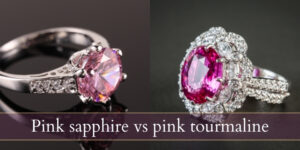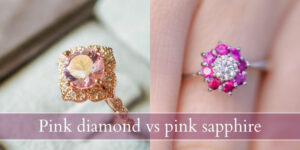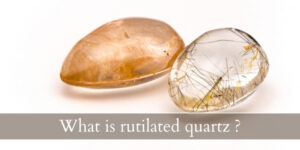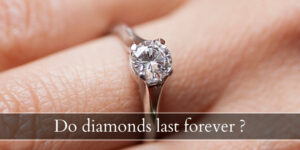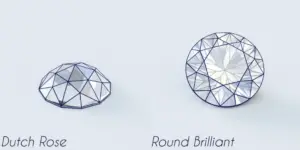Moonstone is one of the most mysterious and beautiful gemstones out there. It managed to be both milky and iridescent at the same time, leading to an incredible glowing effect. And due to its name – moonstone – it simply evokes fantasy, fairytales, magic, and anything even remotely mysterious and intriguing.
The moon has always been a fascination for humans, and moonstone seems like the most natural thing to be interested in. And one of its most interesting features is its glow, and how it never fails to amaze our eyes. So let’s find out how and why a moonstone glows, how it got its name, and what other stones you can use in its place if you ever have to.

Why does moonstone glow ?
Moonstone owes its bluish glow to adularescence, which is the diffraction and reflection of light within the stone as it hits the layers of adularia. Adularia is a type of feldspar, and because of the way it’s layered within the moonstone is reflects the light in a diffused, iridescent way.
A moonstone’s adularescence is similar to a gemstone’s asterism, only it usually has a blue hue instead of white. Moonstone may shine a combination of blue, green, and yellow, with the predominant hue being blue.
As you move the stone, the light source, or your viewing angle the glow will move within the stone. This is one of the simplest yet most fascinating effects of any gemstone, as evidenced by moonstone popularity since it was first found.
The best cut for a moonstone is a cabochon
Because moonstone has a lot of light play to display, it’s best cut into a cabochon to offer the best viewing experience. The fact that this is a soft stone that easily cracks and scratches also makes a cabochon the perfect cut, as it provides more structural stability.
Moonstone scores a 6 on the Mohs hardness scale. This means it’s soft, and it should always be set in a bezel on your jewelry. It also means you should not wear this gemstone everyday if it’s in a ring or bracelet, since it’s easy to scratch and crack. Moonstone earrings and pendants are much better this this gemstone since it protects it better.
High clarity moonstone may be faceted
In very few cases moonstones appears with high clarity. This is relative, since it’s never as perfectly clear as a diamond but compared to how opaque moonstone usually is, a high-clarity moonstone is rare.
These stones may be cut into faceted cuts but with a lot of care, and there should be no overly thin sides. This way it’s easier to prevent crack and fractures.
Still, these stones are soft and should have a bezel setting, unless worn with extraordinary care.
Read also: Why Are Sapphires Blue ?
Why is moonstone called moonstone ?
The Romans believed moonstone was the solidified rays of the moon, due to the iridescent color and white background. This led to the name moonstone, and all other links with the moon, water, feminine energy, and magic.
In some beliefs moonstone is very closely linked to intuition, feminine energy, change (phases of the moon), water, and a woman’s menstruation.
Moonstone alternatives
If you find yourself irresistibly attracted to moonstone but can’t wear it, don’t want to, or can’t find a way to keep it safe on your jewelry, there are other options you can look at. A few of them have the same adularescence as moonstone, and some have a different yet equally striking effect. Here’s a list of the most similar gemstones to moonstone.
White opal
Opal comes in several body colors but the most common is white opal, the same way moonstone has a white body color. Opal shines in colors very similar to moonstone, but the effect is slightly different. The colors look like broken shards, mixed with the milky body of the opal, making for waxing and waning specks of color-change, depending on how you view the opal.
Like moonstone it’s usually cut into cabochons, since opal has a lot to offer a viewer, and it’s a soft stone, softer than moonstone. It scores a 5.5-6 on the Mohs hardness scale, so it will always need a bezel setting and is a bad idea for an everyday ring.
Do not shower with opal. It soaks some of the water and it changes color, losing its milky body and a portion of the colorful shine. Once it’s completely dry (air dried !) it will revert to its original color.
Labradorite
Labradorite is like black moonstone, in that the body color is almost black while the adularescence is bluish, like in moonstone. Where an opal has smaller, broken pieces of various color shining within it, labradorite has sheets of adularia within it but seems closer to the surface.
A labradorite’s blue sheen is much stronger and clearer than a moonstone’s. This is a soft stone, but it’s a little stronger than the others, ranking a 6-6.5 on the Mohs scale. A bezel setting is necessary.
Pearl
Pearls are very different form moonstone, and they come in different hues. But what makes them a great alternative for moonstone is their similar iridescence, even if blue is not the predominant color, and their link to water.
Pearls are formed within clams and oysters, and they range from pearly white to Tahitian black pearls. Most pearls are cultured and farmed, as wild pearl hunting requires killing hundreds of clams to find just one pearl. You can only see the pearl once the clam is opened, and very, very few clams form a pearl.
Because these are not gemstones, they are by definition softer. So soft actually, the rank a 2.5-4.5 on the Mohs scale depending on each pearl. These should never be worn on a ring as they are fragile and are best used for earrings or pendants, and never a bracelet.
Opalite
This is not a natural gemstone by any means, though it may be passed off as faux moonstone. This is a man-made glass that is made to resemble a cross between pal and moonstone. It’s milky or slightly transparent, and has a blue sheen, much like when you drop a bit of milk into a glass of water.
Instead of having a predominantly blue adularescence like moonstone, opalite instead displays adularescence with the colors in an opal’s fire: yellow, green, pink, blue.
If you’re looking for a cheap alternative to moonstone, opalite is not 100% there but it can definitely give you a beautiful effect. You can find this stone in a faceted cut and a cabochon, though being glass it will break easily. Be sure to wear it in a bezel setting and as a pendant or earring, not a ring or bracelet.

I’m the main author for jewelrymaterialguide.com. I started this site after we did tons of research before our wedding and noticed that there is information about rings, jewelry, and so on that is really hard to find on the internet.

